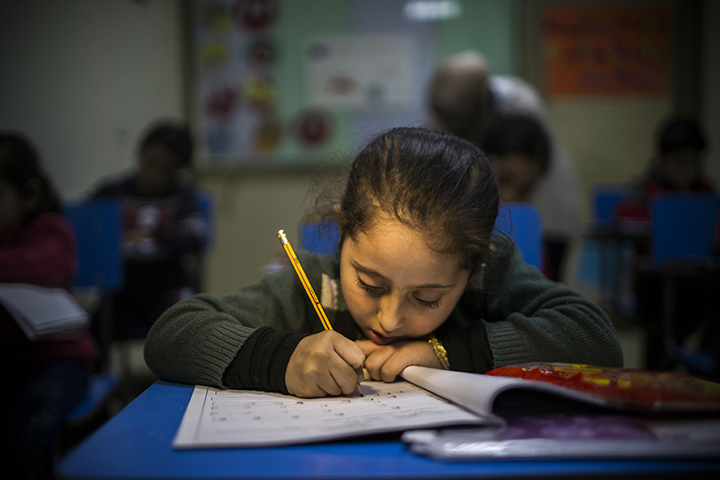 REHABILITATING EDUCATION
REHABILITATING EDUCATION As of now, education needs to be rehabilitated. A number of bogies of this train have derailed from its track. What caused this derailment is largely a matter of debate, as several forces have joined hands to this derailment. I can very well understand that a few idealists who are advocates of the ‘everything is alright’ syndrome may disagree politely or otherwise. But one cannot run away from the realities and facts need to be faced. Let us try to examine a few causes that led to this situation and how we can make our honest efforts to rehabilitate education

1. The goals of education
From time unknown, the objective of education has been to ‘liberate the humans from ignorance’ and ‘to humanise people’ so that they can live in peace as a cohort. It was an instrument to facilitate appreciation of differences and accept them; to care and share so that the resources natural and otherwise are available to all for survival and growth. In due course, the purpose and goal of education embraced the idea of acquisition of knowledge and skills which would help them to unravel the mysteries of an unknown world and to explore the magic spelt by Mother Nature. Thus, apart from a creative exploration and exposition of the unfathomed oceans of knowledge, the process of education found the necessity of reaching out to a social consciousness as integral to itself.
The dawn of the industrial society ushered in several techniques and methods for knowledge exploration and human management through a number of tools and appliances which warranted appropriate, relevant and competent skills. The need and urgency for acquisition of skills outwitted the larger purposes of education iconised so far. The need for competence in relevant areas of knowledge and skills called for certain basic standardization leading to a process of assessment and evaluation leading to a system of examinations. In the entire dynamics of these changing paradigms, the basic goals and objectives of education slowly got marginalized to the extent they have become just ‘annexe’ to the citadel of education. The focus shifted to ‘certification’ and ‘qualification’ of a mass of people to meet the emerging demands of social consumption.
Increased consumption led to a ‘consumerist society’ with market forces ‘creating a need’ for products, whether they were relevant, useful or necessary. The call for “Standards of Life” replaced the “Quality of Life” thus diluting the basic human social fabric based on togetherness, caring, sharing and equity. The concepts of ‘economics refocused on “money matters” and ‘money management’ ignoring the larger base called ‘wealth’ which included several intangible dimensions of human needs for a quality life.
2. The Process of education
The process of education which was basically ‘opening up’ the mind of the learner to curiosity, innovation, creativity and critical thinking was refabricated to ‘bundles of information’ encaged as ‘content’ in a ‘text book’. Thus, the process of the delivery of education became ‘myopic’ – with a need to ‘learn’ the content from a book to ‘deliver’ it at a place and space where it was also tested. The process of discovering knowledge gave way to ‘covering the content’. The “passing out’ parade through an examination brought down the joy of ‘celebrating the knowledge’.
From “Education for Education sake” we moved into a paradigm of “Education for certification sake”. The excessive thrust on celebrating the results of an examination made “celebrating knowledge” an outlaw. The objective of the institutions and their delivery processes found excellent and excessive opportunities for encashing on the ‘stress developed in the process’ opening the doors of “Tuition centres” for “encapsulate information delivery” purposeful to meeting the basic standards called for in an examination. In the entire process a large number of school infrastructures were converted to “Teaching shops”. A minimal pass mark of 35 percent acknowledged gladly the ignorance or stupidity raised by the rest of excellence.
3. Mass Drills in Man-making
With extraordinary thrust on tailored professionalism, several new capsules of information packed into courses of study found ivory towers for their superiority and identity, just because they were new packages. Sheepish mentalities in knowledge acquisition grew abundantly, thanks to the societal fear psychosis tainted with new ‘identities of culture’. Jobs coloured with different collars, created an artificial classism in work culture, triggering a new process of social identities that closed the doors to humanitarian needs and considerations, throwing the concepts of human equities out of gear; however, they highlighted their value by money earning power, opened corridors for a competitive engagement with information rather than knowledge and skills, giving rise to coaching institutes for competition. The basic objectives of education again derailed.
4. Paradigm shifts in social dynamics
With innumerable instruments of technology replacing the human skills, the living styles and relationship dynamics among humans started changing. Institutional infrastructures giving way to customized personal infrastructures, the entire course of human relationship profiles was redefined to fit into the ‘technology dominant culture’. Though technology played an effective role of human facilitation, its predominance as a ‘culture catalyst’ brought social re-organization leading to new social constructs, social relationships and social architecture.
The royal conflict of mind vs matter started playing a dubious game corrupting the week minds navigating them to wrongful and unethical methods of using and abusing technology. With its indomitable speed, technology ushered in an era of restlessness, impulsivity, aggression and achievement syndrome. Education as an instrument of normalizing variant human behaviours and bringing about a ‘behavioural change’ through an articulated delivery of knowledge could not cope with this new challenge. Teachers, who were not trained to meet the emerging social and emotional imbalances through their previously known pedagogical experiences, lost control over the erstwhile structured and organized classroom patterns. Emerging technologies have indeed bridged the gap between what the teachers could deliver and what they could not, but they distanced the inter-personal relationship by creating electronic curtains in the previously existing social constructs.
5. Educational administration in a rough sea
The administration of education had to meet every happening change in the social and knowledge universe. Moving towards managing a system of education to a consumerist society, the Boards of education were left with no option but to construct their curricular edifice to meet the immediate needs and aspirations of an evolving culture. The paradigm shift towards a competitive education forced rearticulating the curriculum and its purpose to these immediate needs. Bridging social inequities through education was indeed a pragmatic problem, but the inadequacy of resources – both financial and human, forced the Boards of education and its managers to compromise with several of the yester years inputs to the modern ‘real-time’ inputs with a lesser value, just because they had a political currency. Frequent and strong interventions by the officialdom and the political cultures forced them to face a ‘survival syndrome’ as against playing a vital role in delivering a system of creative education.
6. Rehabilitation – how and when?

Rehabilitation of education is not a clinical process. Neither does it suggest a period of convalescence when the system could be laid to rest. It is an ongoing pragmatic intervention resulting in an attitudinal change of all stakeholders. The question may arise- haven’t we come so far that we are now in a position where we cannot change. But one needs to be driven by optimism.
What could be some immediate remedial steps?
1. Educational institutions should have less regulations so that they have freedom to exist and operate.
2. The governance should be based on trust rather than mistrust as it exists today. While commercialisation of education has to be discouraged, private interventions for public good should not be seen with a suspicious eye always.
3. Curricular and pedagogical freedom within the framework of the National Policy should be granted to promote innovation and creativity in the corridors of learning.
4. Extensive dialogues on the basic objectives of education with parents and other stakeholders needs to be organized.
5. The curriculum and pedagogy should be directed to enhance the capacity of Learning to Learn, rather than a mis-directed testing on a common yardstick.5. The curriculum and pedagogy should be directed to enhance the capacity of Learning to Learn, rather than a mis-directed testing on a common yardstick.
6. The curricular architecture should have multiple gateways to accommodate learning through all possible informal methods.
7. Learner’s preferences should be considered and celebrated rather than a ‘mass- oriented’ learning culture.
8. With abundant informal learning happening all around, ‘learning’ has to be tested on what one knows, rather than’ what one is expected to know. However, there should be no compromise with basic tenets of quality in education.
9. Diversity has to be encouraged, celebrated, supported to create a wide spectrum of competent human forces rather than setting unwarranted priorities created by mass demands.
10. Realising the quantum leap in knowledge acquisition, management and processing, the logistics of digital education has to be encouraged to make a community of conscious, competent and confident self-learners, who carry a value much higher than what is defined through formal systems.
Rehabilitation calls for a conscious change in our mindset towards education.
Image courtesy:http://foreverkidsacademy.org/wp-content/uploads/2016/11/leaving-your-child-at-preschool.jpg
Image courtesy:http://psikolezyum.com/wp-content/uploads/2016/05/o-CHILD-READING-facebook-e1462290220928.jpg
Image courtesy:https://back-to-the-future.org/wp-content/uploads/2018/06/FOTO-HOMEPAGE-2-min.jpg